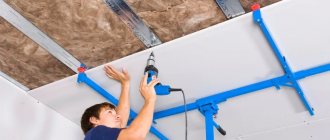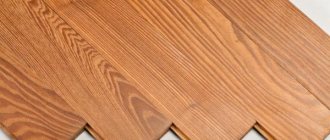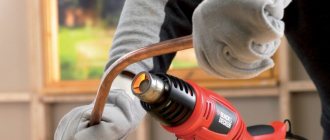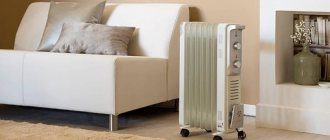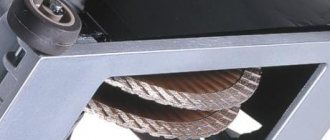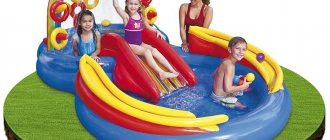- July 27, 2019
- Repair Tips
- Kristina Degtyareva
Construction or renovation is close to completion, the installation of drywall sheets is coming to an end, and therefore a number of questions arise, for example, whether drywall can be painted with paint or not, how to prepare it for this procedure, what materials should be used. When painting drywall, you will have to take many nuances into account. To make your task easier, we have collected all the recommendations in one material. We will tell you what preparatory work will need to be done and talk about the requirements for coloring compositions. In addition, you will find the answer to the question of what paint to paint drywall - the rating awaits you below!
Advantages of gypsum plasterboard staining
There are many advantages to this finishing method. Firstly, it is financial accessibility, and secondly, all painting work can be done with your own hands. Moreover, it is possible to choose exactly the color that matches the original design idea, and if you get tired of it over time, the surface can be repainted with a new one. In general, painting drywall with paint is a demanding task, but not at all difficult. How to prepare for it? Let's tell you right now.
Marking the ceiling and pasting the contours for painting with different paints
By definition, the ceiling is painted first, then the walls. Even so, you should protect the edges of the walls under the ceiling from sloppy brush strokes. Otherwise, you will have to additionally sand and remove the hardened paint from the walls before finishing them. To do this, you can use strips of polyethylene glued with masking tape.
Painting tape will help you paint a wall or ceiling in several colors at once.
If it is not necessary to paint the entire surface of the ceiling with one color, but to create a drawing or pattern, then it is necessary to separate the areas on which paints of different colors will be applied. Directly on the surface of the ceiling, it is best to draw thin lines with a pencil or chalk along the line dividing the zones. Next, the same masking tape is glued to the outside of the area that will be painted first.
Once one area is painted and completely dry, you can cover its edge with masking tape and begin painting the rest of the ceiling.
Preparatory stage
Experts do not recommend applying any paint to an unprepared surface. First, the drywall must be primed and then putty applied to it. For what reasons should this be done? Preliminary preparation is necessary in order to:
- increase the strength of the material;
- enhance the adhesive properties of the surface;
- reduce paint consumption due to the fact that it will be less absorbed into the surface.
Sometimes, after drying, spots appear on the drywall. This drawback can also be eliminated using putty. To carry out the preparatory work, you will need the following tools and materials:
- construction mixer;
- sandpaper – medium and coarse;
- brush (you can use a roller instead);
- screwdriver;
- primer;
- spatulas;
- serpyanka;
- putty – you will need a starting and finishing coat;
- metal corners.
As soon as everything necessary for work is ready, you can begin preliminary work. First of all, you should carefully inspect the surface and eliminate installation defects, if any.
The next stage of work is applying a primer to the drywall. Immediately after this, it is necessary to strengthen the butt and corner parts, do the initial puttying and grouting. Then you need to repeat the priming of the drywall, finishing putty, and then sand the surface. The final stage is finishing priming. Let's consider all the stages in order.
How to prepare material for dyeing
Before painting a plasterboard ceiling, it must be prepared.
In the middle of the plasterboard sheet there is ordinary gypsum, which contains various polymer additives. Such a surface needs a primer, especially at joints and areas where the core of the plasterboard sheet is visible.
On painted drywall, cracks most often form not due to poor installation quality, but due to a violation of the technology for puttying butt joints (see Puttying drywall joints - how it’s done). Their quality is determined by the quality of the raw materials used and the experience of the person performing the work.
Before sealing the seams, prepare the material according to the instructions:
- add the mixture to clean water at room temperature;
- Stir with a construction mixer until the consistency of thick sour cream is formed.
The seams are reinforced.
When puttingtying seams on drywall, additional materials are applied between the sheets, for example, serpyanka - a special tape for reinforcing seams. It can be glued before applying putty or after covering the first layer.
When installing the serpyanka, you should pay attention to the following:
- the material is glued exactly in the middle of the seam;
- pieces of fabric are glued overlapping so that the edges necessarily fit on top of each other;
- The sickle must be pressed into the seam with force;
- if excess putty forms on the drywall, after gluing the tape, they are removed;
- Instead of serpyanka, you cannot use finishing type putty, which is not intended for such work, which can cause cracking of the seams;
- After covering the first layer of material with serpyanka, it must dry, then another layer is applied. In this case, the sealed seams will be smooth and neat;
Tip: Sealing seams should be done with a spatula whose length is greater than the width of the seam. When working, the tool is held so that its edges are on the plasterboard sheet.
Preparing the ceiling for painting
The most economical putty method includes:
- one layer of putty;
- grout;
- final finishing coat.
In this case, the surface will be smooth and beautiful.
Another method that has gained popularity recently involves three layers of coating:
- start processing;
- sanding;
- second layer of putty;
- new grout;
- gluing fiberglass, which provides better adhesion to the materials used in finishing and prevents stretching and shedding of the coating;
- finishing putty of the surface, which makes it possible to obtain a perfectly smooth ceiling plane;
- The ceiling is primed and painted.
Tip: The finishing coat must be applied with a large spatula, and if small irregularities appear, the surface must be treated with fine sandpaper.
Padding
When speaking about whether it is possible to paint drywall without a preliminary primer or not, experts give a negative answer. The thing is that applying a primer improves the adhesive and water-repellent properties of plasterboard. In this case, a special antiseptic should be added to the finished composition, which will prevent the appearance of mold.
As for the choice of primer, any mixture will do, except alkyd primer - it is not suitable for drywall. The primer can be applied with a roller or brush.
How to paint
Before you paint drywall, you need to prepare the surface and certain tools and materials.
Surface preparation
- Applying sickle tape to the seams and then filling with putty through the mesh cells using a spatula. A gypsum finishing or universal putty is used. Thanks to this reinforcement, cracks do not form at the joints.
- Puttying screw heads using the “crosswise” method. It is important to remove excess mixture. Another layer is applied longitudinally.
- Puttying the entire surface to achieve a perfectly even shape. You can apply one thick layer or 2 thin ones. For beginners, it is better to use the second option.
- When the putty dries, it needs to be sanded over the entire area. To do this, use a grinder or hand grater equipped with a sanding mesh. Please note that when performing this work, the light must fall on the surface obliquely. This will make defects more visible. The sanding mesh should be No. 80 for the initial sanding and No. 120 for the final sanding.
- Sweep the sanded surface or remove dust with a vacuum cleaner.
- Apply primer.
The surface can be sanded using a hand float or a special machine.
Attention! Wash the tools and containers thoroughly before each new batch of the mixture. The fact is that the dried solution crumbles and creates lumps that will subsequently remain on the drywall.
Painting tools
- The brush is designed for painting corners and hard-to-reach places.
- The surface of the drywall is covered with a roller. The size and pile of the roller should be medium.
- The spray gun can be used instead of a roller.
- The ditch is used to fill the paint and roll out the roller. It has a tray for the mixture and a rolling platform.
Painting technology
- Cover windows, openings, etc., so as not to get paint on them.
- Dilute the paint in the cuvette. Please note that if the room temperature is too high, you can add a little water (to the water-based emulsion), as the paint will dry out quickly.
- Dip the roller into the dye for a few minutes to completely saturate the pile.
- Transfer the roller with paint to the wave-shaped platform of the cuvette and distribute the coloring liquid evenly over the roller.
- Always start painting from the corners. In this case, a brush is used.
- And only after this the paint is applied to the entire surface using a roller or spray gun.
Which composition to choose
All putties that you can find in construction stores can be divided into three categories:
- Plaster. They are quite often used specifically for working with drywall. Such compositions are characterized by rapid setting and excellent adhesion. True, such putties also have a disadvantage - low resistance to moisture.
- Polymer. They have virtually no drawbacks, the only drawback being their high cost.
- Cement. They are considered by experts to be the best when it comes to drywall. Although such compositions take a long time to dry, they are resistant to moisture.
Main features and requirements for the surface painting process
No one will argue that painting work has been one of the most popular in the design of premises and facades for many years (see also the article “Gypsum putty - characteristics, features and consumption”).
This is due to a number of advantages:
- Simplicity of the process . Any person can paint a ceiling or walls; this does not require complex tools or deep knowledge in the construction industry. The main thing that is required when carrying out work is accuracy.
- Low price of material. There are many product options on the market that will allow you to find the optimal solution for any wallet. At the same time, the coloring quality will be high both for premium-level paints and for economy-class samples.
- The widest choice of colors , which gives almost limitless possibilities when decorating the interior. This became especially evident after the advent of tinting machines, which are capable of making paint of any shade according to a special sample. You simply select the desired option, and the equipment will prepare the composition before your eyes in a matter of minutes.
The choice is made according to the tinting fan, where each color is divided into many halftones of different intensities, and you can definitely choose the right shade
- But not everything depends on the quality of the paint, the right tools and the accuracy of the work. The most important factor is the quality of the foundation, and we will discuss all the nuances regarding this point below.
Drywall paint: which one to choose?
There are a huge number of options for paint and varnish materials. But not all are equally suitable for drywall. So what paint should you use to paint drywall? According to experts, the best option is water-soluble paints. But any paints that contain lime are contraindicated for such a coating.
Of course, it is recommended to choose paint for plasterboard surfaces taking into account the expected operating conditions; you should also focus on the purpose of the surface. Because of this, the texture of the paint is of particular importance. Thus, glossy surfaces can visually expand the space, and they are not difficult to care for. However, the process of painting drywall with glossy paints is labor-intensive; any, even the most minor, flaws will be clearly visible. Matte finishes are one of the best options for ceilings. They are able to hide defects, however, it is quite difficult to care for such surfaces. A compromise option is semi-matte paints, which have the advantages and disadvantages of both options.
Completion
And now the entire surface is painted and has a uniform, beautiful appearance. All that remains is to remove all the auxiliary elements. The masking tape should be torn off carefully, moving the peeled edge away from the surface to be painted. You may need to help things out a little with a utility knife when the paint sticks too much on the tape.
It is best to cover the joints of various painted areas with decorative trims. Ceiling plinths are also fixed around the perimeter of the room.
In order to make sure that the applied paint layer is even, use a bright lamp that illuminates the ceiling at a slight angle. If there are significant differences, they should be localized, combed out and repainted.
Painting plasterboard walls is done in the same way. It is only important to avoid paint smudges and start painting from top to bottom, so that even possible paint lapses and smudges can be easily eliminated without spoiling the already painted surface.
Question of color
When talking about which drywall paint to choose, you should separately consider its color. So, any bright poisonous shades are not suitable for the ceiling. Large surfaces painted in rich colors look great in large rooms, but they are simply out of place in cramped hallways or small kitchens. Designers recommend painting the walls in the living room, hallway, and bedroom in a darker shade compared to the ceiling. This will avoid the feeling of pressure from being in the room. It is not recommended to use the same shade for all surfaces - the ceiling, the floor, and the walls. Contrasting colors can only be used in spacious rooms.
Preparing for painting
First of all, empty the room, cover the windows and doors with film or paper (this is done to prevent paint and small particles from sanding from getting in). To reach the ceiling and upper sections of the walls, a stepladder is useful.
Scaffolding is prepared for working with the ceiling
Use gloves at all stages, and when sanding and painting, use a mask and special glasses.
Preparation for work:
- Priming – the primer is applied with a roller for better contact with the paint; the putty is also covered with a layer of primer. It is not advisable to paint plasterboard sheets directly without priming, since they are unevenly saturated with paint and stains will appear. To prime drywall, you do not need a deep penetration primer; a universal one will do. Two layers of primer are enough, the second is applied after the first has dried.
- Putty joints and seams. The locations of the screws are also puttied. To do this, use a wide spatula and reinforcing tape.
- Sanding with fine sandpaper to final level the drywall is very important when painting the ceiling and when using glossy paints. After sanding, the settled dust is removed with a soft brush or cloth.
Enamel paints
Beginning repairmen often ask whether it is possible to paint drywall with enamel paint. Experts answer: not only is it possible, but it is necessary. This option is considered preferable for several reasons: firstly, enamel paints dry quite quickly, they are durable and allow you to cover the surface of drywall as tightly as possible. True, such paints and varnishes also have disadvantages. For example, they are quite toxic, which means they are not suitable for all rooms. Another disadvantage is the high cost, sometimes simply unreasonably high. It should also be taken into account that before painting with enamel, drywall must be carefully prepared: in addition to the procedures described above, it is necessary to treat the surface with PVA glue.
Water-based paints
When talking about what paint to paint drywall with, we cannot fail to mention water-based paints. They are incredibly easy to apply to the prepared surface, wash off easily from brushes, which means they are suitable for use even by beginners in painting. This paint has many positive properties: it creates a pleasant velvety texture, penetrates perfectly into drywall and thoroughly covers it. When painting drywall with water-based paint, a thin matte film with breathing pores is formed, completely invisible to the naked eye. It should be noted that such materials are environmentally friendly, therefore they are perfect for any residential premises.
Of course, it was not without its drawbacks. For example, the question often arises about whether it is possible to paint drywall in a bathroom with water-based paint. Let's say right away: such compositions are afraid of dampness. Therefore, water-based emulsion is not the best option for rooms with high humidity. Another disadvantage of water-based paint for drywall is that it costs too much.
Water-repellent paints
Water-repellent paints, often called water-dispersion paints, are much better suited for wet rooms. They have many advantages: they dry very quickly, do not have an unpleasant odor, and do not turn yellow over time. In addition, drywall painted with water-repellent paint can be washed up to two thousand times - the surface will not even fade. It is recommended to apply water-repellent paints in three layers. They contain a variety of components, for example, silicate, silicone, acrylic. All this affects the quality of the paint and varnish material.
The best silicone water-based paints
Which paint for drywall should I choose? Experts recommend paying attention to compounds made on the basis of silicone resin: they repel water, and therefore are suitable for rooms with aggressive environments. Which colors to choose? Please note the following:
- TIKKURILA Euro Extra 20. The products of this Finnish company can be called synonymous with quality. Therefore, it is not at all surprising that the winner of the rating was TIKKURILA Euro Extra 20 paint. This composition seemed to combine all the advantages of modern silicone paints and varnishes. It is characterized by resistance to ultraviolet radiation, environmental friendliness, and pure color. True, you should only choose paint that was made in Finland, because the one produced in Russia does not always match the quality of the famous brand. Professionals note: this paint is odorless and resistant to water and household detergents. Its only drawback is the high price, but the excellent quality is worth the money spent.
- Caparol CapaSilan. Which paint for drywall should I choose? Pay attention to Caparol CapaSilan. This paint has increased hiding power - in just one pass, professionals can thoroughly paint ceilings and walls. This, of course, simplifies repair work. Moreover, when using Caparol CapaSilan, cracks up to two millimeters wide can be closed! Painted drywall repels water and dust and is easy to clean using regular detergents. It was not possible to take first place in the rating of Caparol CapaSilan paint only because of its even higher price.
- LITOKOL LITOTHERM PAINT SIL. Thinking about what paint is best for drywall? Pay attention to the premium paint and varnish material called LITOKOL LITOTHERM PAINT SIL. Why is she so good? Professionals note that the surface painted with it is resistant to dirt and humidity, and is not afraid of ultraviolet radiation. Another significant advantage is the huge range of colors. In general, this paint is good for almost everyone. However, in our ranking she only took third place. Why? The thing is that the company’s policy provides for the use of not only paint, but also plaster, primer and putty of the LITOKOL brand. Otherwise, the quality of the finishing coating, experts say, is noticeably reduced.
- ALPINA EXPERT. This paint is included in our rating because it has the lowest price and is very economical in consumption. On average, about 140 milliliters of finishing material will be required per square meter of surface. True, paint also has negative sides. For example, it is not suitable for rooms where there are temperature changes and too high or low humidity levels. In addition, ALPINA gets dirty quickly and is difficult to wash.
The best silicate paints
The use of so-called liquid glass in paint and varnish production makes it possible to obtain a plasterboard surface that is resistant to a variety of negative factors.
Just imagine: silicate paint can be used not only for interior but also for exterior work! At the same time, most manufacturers offer quite affordable prices, which allows you to get a good option for decorating bedrooms, kitchens, bedrooms and children's rooms. What is the best paint for drywall? According to professionals, it is recommended to give preference to the following:
- TIKKURILA FINNGARD SILIKAATTIMAALI. The main advantage of this paint is its wide temperature range of application. Drywall painted with this material will not lose its attractiveness either in frost of -50 degrees or in heat of +60. In addition, when painting, a vapor-tight layer is created that has moisture- and dirt-repellent characteristics. It is worth noting that TIKKURILA FINNGARD SILIKAATTIMAALI was liked not only by finishers - it is often used by owners of small sea vessels, which, of course, is an excellent confirmation of the quality of the material.
- BAUMIT SILIKAT COLOR REPRO. This paint can be classified as an elite quality building material. Liquid potassium glass is an excellent binder; it is characterized by inflammability, resistance to fading, dust, dirt-repellent properties, and vapor permeability. The only thing that does not please specialists and ordinary people is the rather high consumption: about 500 grams of paint may be needed per square meter. Another disadvantage is the temperature range. If the room temperature is below +8 degrees, the paint layer is unlikely to retain its decorative properties.
- Ceresit "ST 54". Are you choosing drywall paint for walls? We recommend paying attention to silicate water-based paint “Ceresit”. It has good hiding power, it contains antifungal components, moreover, the paint is completely environmentally friendly and affordable. True, there are a number of disadvantages; for example, the surface must be perfectly prepared before painting. It is best to use plaster compositions made on a mineral basis.
Acrylic paints
Acrylic paints are great for drywall. They are inexpensive, easy to apply, and very durable. Of course, such paints are somewhat inferior to compositions based on silicone and silicate, but they are well suited for interior decoration. The following paints received high marks from experts:
- DULUX MASTER LUX AQUA 40. This paint is the best option for painting plasterboard walls and ceilings. The main characteristic of the material is its light absorption. Thanks to this property, the paint is able to mask minor surface errors. The covering power of the composition is high enough that in order to get an ideal wall or ceiling, just a couple of layers are enough. Add here the absence of unpleasant odors during operation, acceptable consumption and environmental friendliness of the material - and you will understand why this paint is quite expensive.
- ALPINA RENOVA. The experts also liked the white paint for plasterboard ALPINA RENOVA. The main advantage can be considered the preservation of the original whiteness for seven years after painting the surface! However, you can add any color to the base, of course, produced by ALPINA - in this case, the paint will not turn yellow until the next repair. Caring for drywall painted with this composition is quite simple: it does not fade and is not afraid of dirt and dust. It is also important that painted surfaces withstand temperature changes and high humidity. The only thing that can be considered a drawback is the high consumption: about 250 grams per square meter.
- FARBITEX PROFI. This is a budget option for drywall paint for walls and ceilings. Its main ability is water-repellent, thanks to which the paint can be used in living rooms, as well as in the kitchen and bathroom. The consumption is quite economical: only 90-100 grams of paint are required per square meter. In addition, FARBITEX PROFI is characterized by a low price. The composition also has negative sides, for example, too thorough wet cleaning can lead to complete erasure of the coating.
Features of drywall and its varieties
Nowadays it is very difficult to find a room or residential apartment that does not have drywall. This versatile material provides enormous scope for creativity and competent design. It gained such popularity due to a number of advantages:
- Ecologically friendly;
- Not afraid of fire;
- Affordable for almost any consumer;
- Blocks out extraneous noise well;
- After repair, a minimal amount of waste remains from it;
- Adjusts to room humidity; if necessary, absorbs excess moisture, and when the air dries out, releases it;
- Unpretentious in finishing and repair;
Drywall has several varieties, each of which requires its own approach.
- Consisting of sheets (standard);
- Moisture resistant. Only this type is suitable for arranging bathrooms and restrooms.
- Ceiling. It is used when installing simple or multi-tiered ceilings.
- Fire resistant. Not afraid of open flame, does not deform.
- Arched. Suitable for the manufacture of non-standard shaped elements.
- Acoustic. This type of drywall is used exclusively for rooms with high noise levels and requiring mandatory sound insulation. Such gypsum boards are characterized by the presence of frequent holes a centimeter wide and a soundproof layer.
Latex based paints
Having trouble choosing drywall paint that is durable and inexpensive? Professionals advise choosing latex paints.
Previously, they were made on a rubber basis, but today polymers are used for them, which has significantly reduced their price. In terms of their characteristics, such paints and varnishes are second only to silicone paints. Which latex paint for drywall should I choose? Experts recommend choosing materials such as:
- TIKKURILA EURO POWER7. This coloring is ideal for various types of surfaces, including drywall. It can be diluted with water - no more than 5-10%, the amount of water depends on the method of application. The advantages of the paint include average consumption (about 110 ml per square meter), resistance to moisture, easy care - you can use detergents to wash surfaces.
- Dufa Retail Eurolatex 3. German latex paints - an example of the highest quality combined with an affordable price. Professionals say: the paint has incredible covering power, has a long service life, and even aggressive household chemicals can be used for cleaning. The only downside is that after drying the color of the paint may become darker.
- DULUX Bindo 7 BW matte. This latex paint is characterized by a high cost. This can easily be explained by the fact that it belongs to the category of professional materials. When applied, no drips or streaks are formed, the paint does not splatter, and it is also environmentally friendly, which allows it to be used even in children's rooms and the kitchen. The covering power of the material is good; in order to paint drywall with high quality, two layers are enough. You can wash surfaces with any detergents - except those that contain abrasive components.
- NewTone Sky. Do you like snow-white walls and ceilings? Take a closer look at this paint! It is ideal for decorating plasterboard surfaces in heated rooms with normal humidity levels. You can achieve a stunning white shade with just two layers of paint. Of course, you can add different colors to the base. Among the disadvantages, experts note a rather high consumption - about 120 grams per square meter; in reviews, finishers often talk about the paint’s hiding power not being the best.
Coloring
Now the most important and time-consuming stage has arrived. Whatever high-quality paint is used, it must be applied in several layers. The putty and all areas that differ in color or texture from each other will still be visible through the first layer, and subsequent layers will finally equalize the color of the surface and form the final appearance.
To start, use a brush. It is necessary to paint the entire perimeter of the area that is to be opened first. In addition to the perimeter, the edges of any obstacles are also painted with a brush. Be it a transition from level to level or a ledge, or a base for a chandelier. This provides some margin so that you don’t have to bring the roller directly to the obstacles and not get them dirty again. For this purpose, it is better to take a flat brush with a width of 60-80 mm.
The paint is poured into a special paint bath, which makes it convenient to roll in the roller. Then, with a bath and a portion of paint, you can move around the room more easily. The roller is initially dipped directly into the paint bucket so that it is completely covered with it. This is necessary so that the paint spreads evenly over its entire surface. It is quite difficult and time-consuming to initially roll out the roller only in a paint bath. Once the roller is completely covered with paint, the task becomes much easier. Next, you can start painting the main area.
When painting, the following rules are observed, as the technology says:
- When applying each layer, the roller is always rolled in one direction.
- It is enough to swipe one strip 3-4 times to distribute the paint evenly.
- A large surface should be painted in stripes perpendicular to the direction of movement of the roller and 60-80 cm wide. Accordingly, the roller should be rolled the same 60-80 cm.
- As soon as the paint is rolled out from the roller, you need to walk it over the newly painted area. This will completely distribute the paint.
- Under no circumstances should you roll the roller over a place where the paint has already begun to set. In other words, do not return to repaint areas where you have already painted and more than 5 minutes have passed.
- The next layer is applied using roller movements perpendicular to the previous layer and only after all previous layers have completely dried.
Each subsequent time, when there is no paint left on the roller, it is enough to lower it one part into the tray and roll it on an inclined surface to distribute the paint.
Each new layer again begins with painting the perimeter with a brush.
If an error or stain is noticed, you should act according to the circumstances. Unpainted areas must be filled in after the base layer has already dried. When there is a stain with excess paint, you should not try to rub it when it has already set. You will have to wait until it dries and carefully clean off the excess with sandpaper, and then paint it again.
It is much more difficult to apply glossy paint. If significant defects appear, the surface at the defect site should be leveled and the entire surface again covered with another layer. This is the only way to avoid the appearance of streaks and noticeable stripes.
Coloring tricks
What do you need to know when painting drywall with water-based paint, latex-, silicate- and silicone-based paints? For uniform coloring, experts recommend applying paint in three layers - the first and third should be vertical, and the second should be horizontal.
Another secret from the professionals: it is recommended to start painting from the corners. It is better not to take breaks during the process, otherwise you risk getting a large number of defects. It is also not recommended to change the roller during the process.
Materials and tools
To begin with, it is necessary to carry out a number of preparatory measures, so you cannot do without the following devices:
- set for applying plaster – spatula (50 and 500 mm), mixer, sandpaper;
- additional devices – electric drill, mixer attachment;
- painting equipment – roller, brushes, paint container, masking tape.
You can use a spray bottle to apply the dye. It will not only make the work easier, but will also allow you to obtain a layer of equal thickness and reduce material consumption. If you don’t have such equipment, you’ll have to arm yourself with brushes and paint the drywall yourself.
Painting instructions
First of all, you need to prepare the surface for painting, then you should take all the necessary tools and just carefully apply the paint. The principle of painting depends on the type of material you use. How to paint drywall with water-based paint? You just need to apply it in several thin, even layers. It is recommended to apply the enamel in three layers - the first should be zigzag, the second should be fairly dense and uniform, and the third should be a thin finish. At 20 degrees Celsius, drywall will dry completely in just a day. And one more rule: if you do not want to get defects on the dried surface, make sure that there is no draft in the room.
To paint the ceiling, use rollers with long handles or sprayers. Like walls, plasterboard ceilings will take about 24 hours to dry. If necessary, after the surface has completely dried, you can apply an additional layer of paint.
Application technology
Water-based paint is applied to the wall in 2-3 layers. There is no need to wait until the painted drywall in each layer dries, since it is applied “wet on wet”.
Enamel and oil are worn in 3 layers. Moreover, the first one is smeared on the wall in zigzags and then the paint is distributed with a roller. The second layer should be thick, and the third, on the contrary, thin.
You should start painting from the corner of the room. And for this we use a brush. Then they put the roller into action. By the way, you only need to paint from the ceiling to the floor - this is mandatory.
If you leveled the wall with putty, then before starting work, fresh areas should be painted separately. And only then proceed directly to painting the wall itself.
Using multiple shades
Today, painting walls in different colors is more important than ever. Working on such a coating will not take much time. First you need to draw a sketch on a sheet of paper, and then transfer it to the surface of the gypsum board using a pencil. The part that does not need to be painted immediately should be covered with masking tape. After painting, you should wait until the surface is completely dry and then continue painting the wall. Please note: you must try to carry out all the work at once, without interruption. You should not repaint a previously started surface where the paint has already dried, otherwise you will get an uneven coating and mismatched shades.
How to paint drywall: detailed execution technology
Today, plasterboard sheets are one of the most popular materials for leveling walls. Due to their structure and smooth outer surface, gypsum boards are perfectly combined with any type of finishing. The current option for the latter is still painting the walls. To get a high-quality and aesthetic finish, you need to clearly understand how to paint drywall
competently and most effectively.
All types of paints do an excellent job, but the main selection criterion is the final desired result.
If you are painting drywall in a small room, it makes sense to create a glossy surface - paint the gypsum board using alkyd enamel.
It is worth noting that manufacturers are constantly improving their products and releasing them with more advanced properties. Now you can buy paint that is odorless or dries very quickly. Whatever is in demand will also be in supply.
This axiom is very clearly visible in the construction market of finishing materials. As practice shows, it is rational to use a flat brush, the width of which does not exceed 10 cm; the ideal option would be a thin flute brush. Having such a variety at your disposal, before going to the store you should already clearly know what you want to get in the end.
